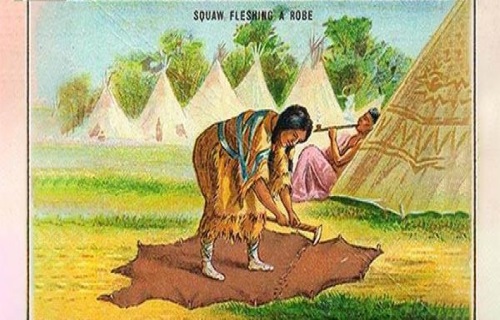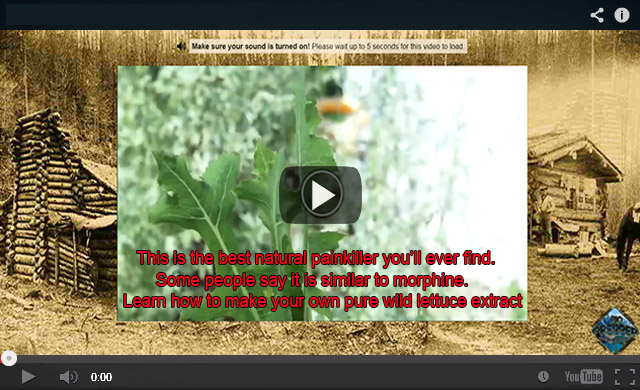Originally Published : By Julie Dees
It is always fascinating to see how other people live or to speculate how our ancestors went about their daily lives. The foods they eat, how they care for their children, and their basic everyday activities can tell us quite a bit about them. Today we’re getting a glimpse into Native American life from 150 years ago.
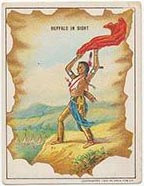
For the Native Americans, the herds of buffalo were one of the most important resources they had. In addition to meat, the animals provided them with clothing, shelter, and trade items.
Buffalo in Sight ~ One scout would be sent to the top of a hill neighboring the camp to act as a lookout for the buffalo herd. When the animals were sighted, the scout started waving a blanket to signal the camp.
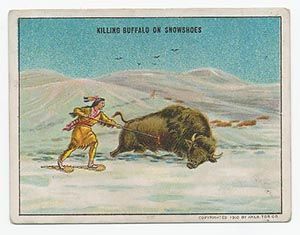
Killing Buffalo on Snowshoes ~ Heavy snows put them on a more even footing with the large buffalo, allowing them to spear the animal.
By donning snowshoes, the hunter was able to stay on top of the snow even as the buffalo sank through it.
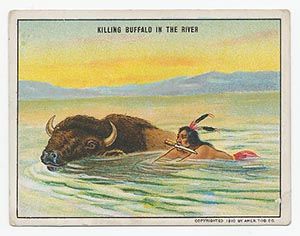
Killing Buffalo in the River ~ The Native Americans were adaptable and courageous when hunting, using various skills including swimming. They often managed to kill a buffalo by swimming next to it as it crossed a river.
Using only their knife, they would cut its throat and then depend on their own swimming ability to stay out of its way as it weakened.
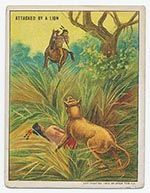
Life was full of danger for the Native Americans. They battled nature and the damage it could inflict as well as always trying to keep other tribes from stealing their horses, women, and food.
Attacked By a Lion ~ The hunter often became the hunted when dealing with a mountain lion. These wily cats were known by different names depending on what part of the country they lived in – puma, panther, and catamount.
These big cats wrought havoc on prey animals such as cattle, sheep, and goats. The risk they posed to the horse herds along with the value of their skins were just two of the reasons they hunted them.
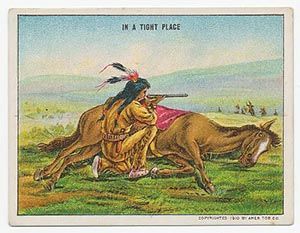
In a Tight Place ~ Superior numbers of hostile tribes were a constant threat. A lone scout out in the open could depend on his horse to help protect him.
These horses were trained to lay down quietly and provide a living shield for his master.
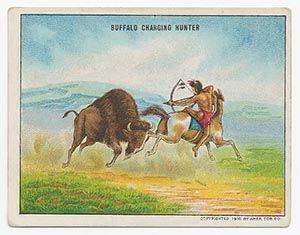
Buffalo Charging Hunter ~ Hostile tribes weren’t the only thing that charged at or tried to run down the brave Natives. Large buffalo cows and bulls could turn from prey to hunter in a moment’s notice.
Once again, the well-trained and lightning-fast horses came to the rescue. As the hunter was only armed with a bow and arrow, it was necessary for the agile horses to get them close enough for the kill but to also keep them out of harm’s way.
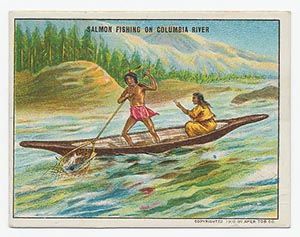
Native Americans used boats for more than just fishing. As their skills grew, so did the purposes and types of their watercraft.
Salmon Fishing on Columbia River~ Contrary to popular belief, not all canoes or boats built by the Native Americans were made from the bark of birch trees.
Birch doesn’t grow on the banks of the Columbia River, the Natives used whatever trees were available and suitable to carve their dugouts like the one above.
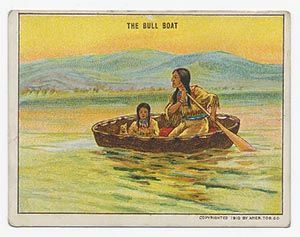
The Bull Boat ~ The bull boat is known to be one of the most primitive boats in the world and is so named because of the bull hides originally used in its making. Raw hides that have been soaked in water are stretched over a wood framework.
The hide was then bound in place and allowed to dry in the sun until it was as hard as bone and waterproof.
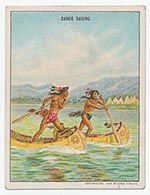
Canoe Racing ~ Crafting canoes was a skill in which many Native Americans excelled.
The canoes were quite fragile while being strong and sturdy at the same time.
Young tribesmen enjoyed racing their craft to show off their abilities.
Horses were a vital part of daily life for Native Americans. Transportation, hunting, trading, and even food were some of what horses offered the tribes.
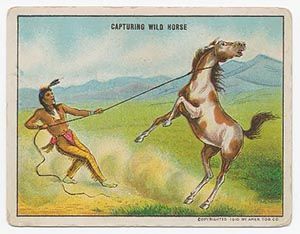
Capturing a Wild Horse ~ While the Natives were expert horsemen, they weren’t in the business of breeding horses. The replenished their horses on a regular basis by using their current mounts to help them capture new ones from the wild herds. Stealing horses from other tribes was also a common occurrence.
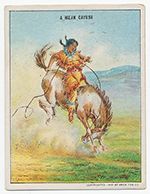
A Mean Cayuse ~ Ponies or horses were also known as a cayuse or broncho. These wild horses were frequently found to be difficult to tame and train. It required extensive horsemanship skills to accomplish this, but once trained, they became a highly prized possession.
A little-known fact is that it was quite often the squaws who were the horse trainers. Their abilities rivaled and even surpassed those of the men at times.
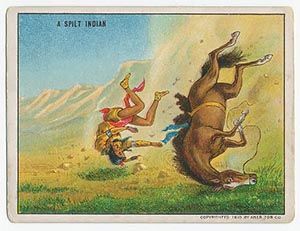
A Spilt ~ Due to their excellent horsemanship and the agility of their horses, they often took risks that ended in disaster.
Accidents were common as the riders asked their mounts to perform unsafe maneuvers.
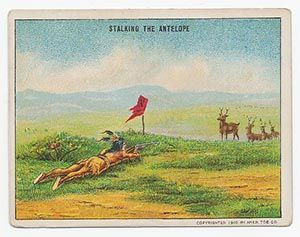
The Native Americans were primarily hunters and gatherers. While the women took care of all of the gathering and some of the fishing, the men were expected to provide the game.
Stalking the Antelope ~ Because the antelope or pronghorn is an extremely curious creature, it is also one that easily falls prey to hunters. Their natural tendency is to investigate anything new or unusual in their surroundings.
A common ploy was to tie a bright piece of fluttering cloth on a stake in the ground. The hunter then lay in wait for the nosy antelope to approach and become easy targets.
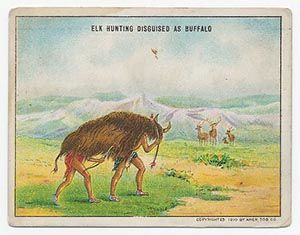
Elk Hunting Disguised as a Buffalo~ Before they relied on the use of guns for hunting game, they had to improvise in order to get up close to the elk herds.
By covering themselves with a buffalo hide, they were able to creep in near enough to the animals to kill them with their bows and arrows.
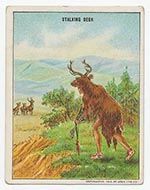
Stalking Deer ~ Similar to their method of stalking elk above, they commonly covered themselves with the head and hide of a deer in order to approach the wily animals.
As their bows and arrows were ineffective from long ranges, they needed to close in on their quarry before being detected.
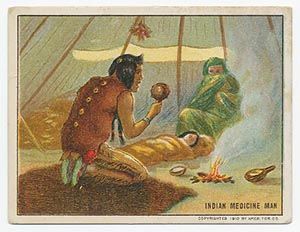
The medicine man and chief tended to stay in or near camp most of the time. In some tribes, they were even the same person.
Medicine Man ~ With little to no knowledge of drugs or more modern methods of treating diseases, the Medicine Man used other ways to attempt to drive evil spirits from his patients. He relied heavily on chanting, shaking his medicine rattle, and burning sweet smelling herbs. Find out the medicinal plants the Native Americans used on a daily basis.
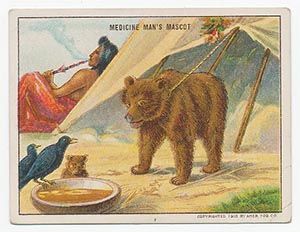
Medicine Man’s Mascot ~ The Medicine Man was widely respected for more than just his healing arts, he was also admired for the pets or mascots that he kept.
It was not unusual for him to have tamed bears, pet crows, and trained dogs.
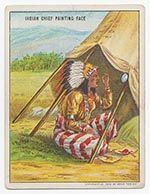
Chief Painting Face ~ Painting their bodies and faces with bright stripes of color was something the Natives did on a regular basis. In times of peace it was for decoration. While engaging in war, it was meant to distract and terrify their enemies.
Carrying small mirrors or looking glasses was common as they were also used for ornament and as signaling devices.
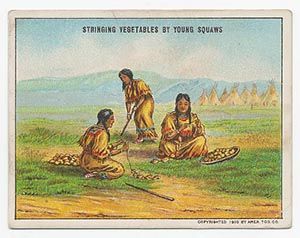
The women and squaws were the hardest working group of the tribe. Their many responsibilities and tasks kept the camp in order and functioning. Aside from hunting and fighting, the men didn’t do much else as they thought ordinary tasks were beneath them.
Stringing Vegetables By Young Squaws ~ The Native Americans didn’t do much gardening, they depended more on gathering vegetables that grew wild. One of these prized plants was known as pomblanch or white root.
Once it was gathered it was strung by the young squaws, dried in the sun, and then pounded until it turned into a flour.
RELATED : 24 Lost Gardening Tips from 100 Years Ago
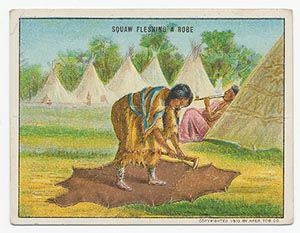
Squaw Fleshing a Robe ~ Once the hunter killed the animal, his job was done and the squaw was expected to do everything else. This image shows her preparing the skin as her husband lounges against the tent smoking.
She will eventually either use the skin for her family or as a trade item, bartering it for sugar, flour, and possibly calico fabric at the trader’s store.
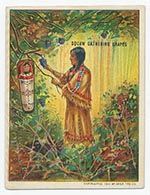
Squaw Gathering Grapes ~ It was not uncommon for the women of the tribe to travel long distances searching for wild fruits, roots, and vegetables. Grapes were a staple that they dried in preparation for winter use.
The squaws often took their baby or papoose with them while gathering, sometimes hanging them in their board from a branch. This allowed them to keep an eye on the baby.
So now you’ve had a chance to see what went on in a typical day in the life of a Native Americans. Would you have enjoyed that lifestyle? (source)
Our grandfathers had more knowledge than any of us today and thrived even when modern conveniences were not available. They were able to produce and store their food for long periods of time. The Lost Ways is the most comprehensive book available. All the knowledge our grandfathers had, in one place.Here’s just a glimpse of what you’ll find in the book:
Table Of Contents:
Making Your Own Beverages: Beer to Stronger Stuff
Ginger Beer: Making Soda the Old Fashioned Way
How North American Indians and Early Pioneers Made Pemmican
Wild West Guns for SHTF and a Guide to Rolling Your Own Ammo
How Our Forefathers Built Their Sawmills, Grain Mills,and Stamping Mills
How Our Ancestors Made Herbal Poultice to Heal Their Wounds
What Our Ancestors Were Foraging For? or How to Wildcraft Your Table
How North California Native Americans Built Their Semi-subterranean Roundhouses
Our Ancestors’Guide to Root Cellars
Good Old Fashioned Cooking on an Open Flame
Learning from Our Ancestors How to Preserve Water
Learning from Our Ancestors How to Take Care of Our Hygiene When There Isn’t Anything to Buy
How and Why I Prefer to Make Soap with Modern Ingredients
Temporarily Installing a Wood-Burning Stove during Emergencies
Making Traditional and Survival Bark Bread…….
Trapping in Winter for Beaver and Muskrat Just like Our Forefathers Did
How to Make a Smokehouse and Smoke Fish
Survival Lessons From The Donner Party
Get your paperback copy HERE
Here’s just a glimpse of what you’ll find in The Lost Ways:
From Ruff Simons, an old west history expert and former deputy, you’ll learn the techniques and methods used by the wise sheriffs from the frontiers to defend an entire village despite being outnumbered and outgunned by gangs of robbers and bandits, and how you can use their wisdom to defend your home against looters when you’ll be surrounded.
Native American ERIK BAINBRIDGE – who took part in the reconstruction of the native village of Kule Loklo in California, will show you how Native Americans build the subterranean roundhouse, an underground house that today will serve you as a storm shelter, a perfectly camouflaged hideout, or a bunker. It can easily shelter three to four families, so how will you feel if, when all hell breaks loose, you’ll be able to call all your loved ones and offer them guidance and shelter? Besides that, the subterranean roundhouse makes an awesome root cellar where you can keep all your food and water reserves year-round.
From Shannon Azares you’ll learn how sailors from the XVII century preserved water in their ships for months on end, even years and how you can use this method to preserve clean water for your family cost-free.
Mike Searson – who is a Firearm and Old West history expert – will show you what to do when there is no more ammo to be had, how people who wandered the West managed to hunt eight deer with six bullets, and why their supply of ammo never ran out. Remember the panic buying in the first half of 2013? That was nothing compared to what’s going to precede the collapse.
From Susan Morrow, an ex-science teacher and chemist, you’ll master “The Art of Poultice.” She says, “If you really explore the ingredients from which our forefathers made poultices, you’ll be totally surprised by the similarities with modern medicines.” Well…how would you feel in a crisis to be the only one from the group knowledgeable about this lost skill? When there are no more antibiotics, people will turn to you to save their ill children’s lives.
If you liked our video tutorial on how to make Pemmican, then you’ll love this: I will show you how to make another superfood that our troops were using in the Independence war, and even George Washington ate on several occasions. This food never goes bad. And I’m not talking about honey or vinegar. I’m talking about real food! The awesome part is that you can make this food in just 10 minutes and I’m pretty sure that you already have the ingredients in your house right now.
Really, this is all just a peek.
The Lost Ways is a far–reaching book with chapters ranging from simple things like making tasty bark-bread-like people did when there was no food-to building a traditional backyard smokehouse… and many, many, many more!
Books can be your best pre-collapse investment.
The Lost Ways (Learn the long forgotten secrets that helped our forefathers survive famines,wars,economic crisis and anything else life threw at them)
Survival MD (Best Post Collapse First Aid Survival Guide Ever)
Conquering the coming collapse (Financial advice and preparedness )
Liberty Generator (Build and make your own energy source)
Backyard Liberty (Easy and cheap DIY Aquaponic system to grow your organic and living food bank)
Bullet Proof Home (A Prepper’s Guide in Safeguarding a Home )
Family Self Defense (Best Self Defense Strategies For You And Your Family)
Survive Any Crisis (Best Items To Hoard For A Long Term Crisis)
Survive The End Days (Biggest Cover Up Of Our President)
Drought USA (Discover The Amazing Device That Turns Air Into Water)

